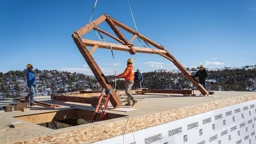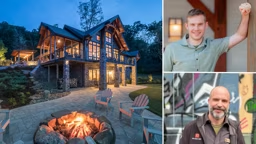
1. Create a workable schedule.
Like any type of custom construction, building a timber home isn’t a speedy process. Set aside six to seven months to refine your home’s design, which will be when you create your floor plans and working drawings. After that, allocate another two months for the timber to be cut and delivered to your building site. Raising and enclosing the frame takes approximately one week. Finishing the interior can take anywhere from two to nine months or more.
2. Finalize building permits and details.
While your timber producer prepares the wood for delivery, your general contractor (GC) should be using that time to obtain and pay for various clearances (including the all-important building permit) so that construction can begin on schedule. He should talk to the local building authority and your lender to determine when each will require inspection of his work. To keep things on schedule, he should contact the local power company to arrange for temporary electrical service at the site. If you’re building in a rural area, he also may need to schedule a crew to install the well and septic systems.
See also How To: Avoid the pitfalls of private road ownership
3. Prepare the site.
Several weeks before the arrival of your home components, a surveyor will come to your property, mark the boundaries of the house, and indicate where the footings and foundation should be. An excavator will clear the site of trees and brush, and put in a rough road so that the contractor’s equipment and deliveries can reach the building site. With a temporary road in place, the subcontractors hired to dig the well and set up the septic system can start to drill for water, lay out a drainage field and bury the septic tank in the ground.
4. Build the foundation.
Before the timber is delivered to your site, the foundation will need to be completed. The footings will be set first, then checked and approved by the local building inspector before the foundation walls or piers are erected. Footings are crucial because they enable the weight of the house to be distributed to the ground over a larger area. In addition, they serve as a level surface on which to set the foundation walls. Your timber home company will supply the general contractor with specifications for the type of foundation your house needs. There are several types of foundations: poured concrete, concrete block, pre-cast wall, concrete slab and pier. The type that’s chosen for your home is governed by several factors, including the site’s characteristics, the type of soil, the local climate, the design of the house and your budget.
5. Unload and inventory the timbers, and raise the frame.
At this time, the timber package will be delivered to the site, and the framing crew will unload it from the delivery truck either by crane, forklift or hand. The crew will then inventory and organize the timbers by function — posts, beams, braces and the like — to expedite construction. The crew will then raise the frame (bent by bent or section by section) depending on its overall design. Timber homes tend to go up quickly, so there’s a measure of instant gratification at this stage in the process.
6. Enclose the exterior.
In the weeks following the raising, the materials that will form the exterior walls and roof will be attached to the frame. Installing structural insulated panels (SIPs) is the most frequently used method to enclose a timber home. SIPs also are sometimes used as the base for a timber home’s roof. They’re usually nailed directly onto roof timbers. If not, decking is nailed to the timbers first as a base for layers of rigid foam insulation. The roofing will then be covered with any type of finishing material and work on the exterior will continue with the installation of windows and doors, and painting of the siding and trim. Around the same time, the crew will build the garage and any porches and decks the design calls for, and a mason will construct the fireplace.
7. Round out interior spaces.
Once the home is fully enclosed and protected against the elements, the GC will focus on the interior. The basic systems of the house will be put into place in this order: plumbing; heating, ventilating and air conditioning (HVAC); and electrical wiring. These systems, installed by subcontractors, are concealed within interior walls, which are constructed with conventional wood-stud or steel framing. Once you obtain the inspector’s seal of approval, the interior walls will be enclosed. Next, the flooring (anything from hardwood to tile) will be laid. Then it’s time to bring in the kitchen appliances and bath fixtures, and install the cabinets and countertops. Once those are in, the plumbing, HVAC and electrical subcontractors will return to hook up everything. The electrician will hang light fixtures and install receptacles throughout the house. The plumber will set tubs, toilets and install sinks. He or she will also connect plumbing fixtures to the main incoming and wastewater lines. Heat registers and thermostats will be hooked up, and trim carpenters will affix the doors, window treatments and hardware.
8. Apply the finishing touches.
Toward the end of construction, the driveway will be poured. The excavator will return to give the site a final grading, which ensures proper drainage of rainwater away from the foundation. (This step is done late in the construction process to give the foundation’s backfill time to settle.) The roofing contractor will install gutters and downspouts. And, finally, the landscaper will seed the yard and plant shrubbery.











